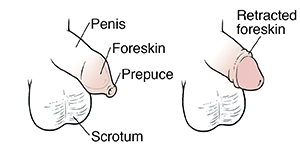Your child has been diagnosed with phimosis. This is a condition in which your child’s foreskin doesn’t move over the head of the penis the way it should. Without treatment, phimosis can cause problems for your child as he grows and matures. Your child’s health care provider will talk with you about the best way to treat phimosis.
Understanding phimosis
Phimosis is normal in newborns and young boys. It protects the head of the penis from getting injured, becoming too dry, or coming into contact with germs. In uncircumcised boys, the foreskin lies over the head of the penis. It starts to loosen from the head of the penis by age
What causes phimosis?
In congenital phimosis, the foreskin doesn't go away by the time the child reaches puberty. The exact cause of this phimosis is not known. It is most likely to be identified in boys between ages 4 and 7.
Sometimes the pulled back foreskin is unable to return to its normal location after urinating or washing. It forms a tight ring that restricts the blood supply to the tip of the penis. This is known as paraphimosis. It is caused by:
-
Injury to the penis. such as small tears that happen when a child’s foreskin is forced back.
-
Infection caused by not washing the area well.
-
Scar tissue on the foreskin due to inflammation or some skin conditions.
How is phimosis diagnosed?
Phimosis is easily diagnosed during an exam. For the exam, the provider will need to look at and handle your child’s penis. You can help make your child more comfortable by reassuring him that this is OK.
How is phimosis treated?
To treat phimosis, the provider may advise:
-
Slow, gentle retraction of the foreskin. You will be taught how to do this at home.
-
A prescription steroid cream. The cream helps to promote skin loosening. The provider will show you how to use it.
-
Removing the foreskin (circumcision). This may be advised if your child’s phimosis is severe.
-
Keeping the skin under the foreskin clean prevents infection and keeps phimosis from coming back.
-
Paraphimosis is a medical emergency that should be treated by a provider right away.
What are the long-term concerns?
If phimosis is not treated, it can cause problems as your child gets older. The flow of urine from the penis may become blocked. This can make urination messy or difficult. It may also increase the risk for infection because of trapped urine.
If paraphimosis is left untreated, it can cut off blood flow to the tip of the penis. In rare cases, this may lead to damage to the penis tip, gangrene, and loss of the penis tip.
It's important to understand that uncircumcised boys may be at greater risk of certain health problems, including balanitis and other infections of the penis. This is because of the buildup of dead cells under the foreskin and the resulting poor hygiene. Uncircumcised men may also be at increased risk of cancer of the penis, but more research is needed.
When to contact your child's doctor
Contact your child’s provider right away if:
-
Your child's foreskin is retracted and won't go back over the tip of the penis (paraphimosis).
-
There is bleeding from the foreskin.
-
Your child has pain during foreskin retraction.
-
There is redness or swelling of the penis.
-
You see any discharge from the foreskin.


